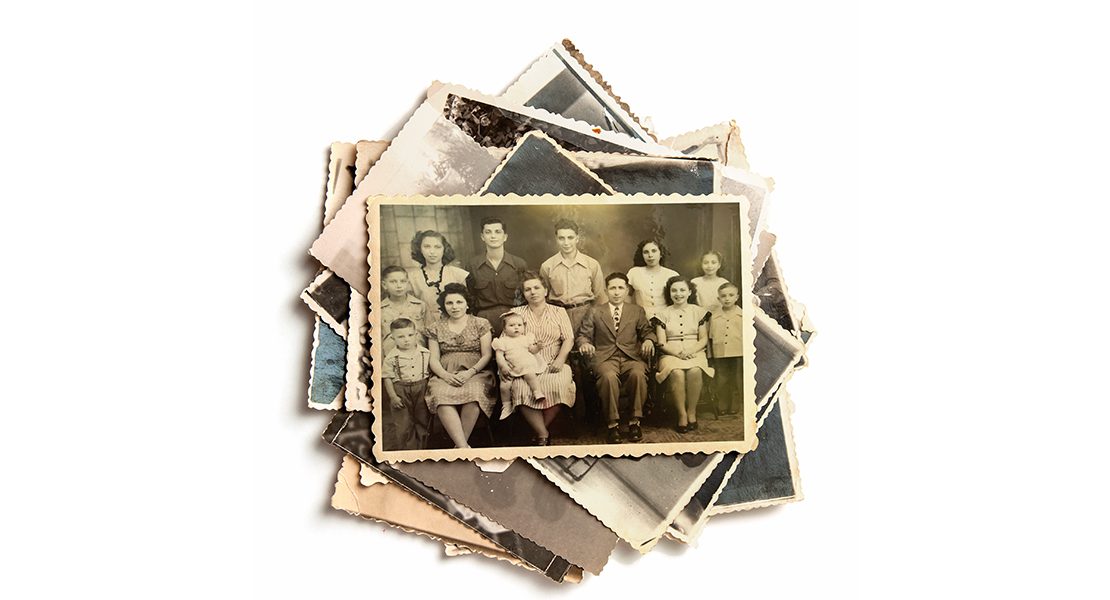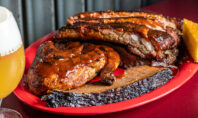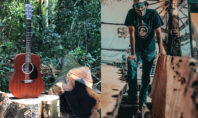Marie Tambasco: An Extraordinary Example of Motherhood

During a lifetime that stretched from 1905 to 2001, Marie Tambasco was witness to a period of history that brought astonishing changes to nearly every aspect of existence. However, this Shenandoah native was usually far too busy with her natural calling to take much note of the evolving world outside the anthracite coal-mining community in Pennsylvania’s Schuylkill County. Raising her own 12 children and caring for 5 younger siblings was a more than full-time occupation for this remarkable and resilient woman. During an interview with a Pottsville newspaper in the final year of her life, Tambasco stated a belief that it was “her God-given role in life to be a mother.” And there’s ample evidence to support that conviction. As daughter and eighth-born child Julia Tambasco McLaughlin recalls, “She was strong and jolly— and never complained.”
A MATCH MADE IN SHENANDOAH
When Marie Panzariello married at just 15 years of age—not unreasonably young in that place and time—her husband Joseph Tambasco was 21. He had arrived in the U.S. at age 16, accompanied by his father. The two planned to work a few years while staying with relatives, save money, and return to the family that remained in Italy. But Joseph chose to stay in America and never set foot in Italy again. When he began to court Marie she was not quite 14. Her mother Maria objected to Joseph’s attentions due to his reputation as an alleged “womanizer.” (Good looks and an outgoing personality are assumed to be all the fodder needed for local gossipmongers to start whispering.)
After church one Palm Sunday, Joseph presented Marie with a tiny cross adorned with two hearts he had woven from the palm leaf given to worshippers that day. An epic mother-daughter battle ensued, with Maria insisting the gift be returned and Marie refusing to follow orders. In this instance, the otherwise obedient daughter prevailed: Marie cherished the handcrafted token throughout her life—usually carried in her purse—and requested to have it placed in her casket when she died. (In an odd footnote, one of the two hearts fell off the palm leaf cross the day Joseph died in 1976 and, despite intense searching, was never found.) Fortunately, Marie’s father Giovanni was eventually convinced of Joseph’s honorable intentions and his approval outweighed Maria’s misgivings.
THE FAMILY GROWS (AND GROWS)
The couple’s first daughter, Carmella, was born the next year when Marie was 16. By 17, her responsibilities increased dramatically. On July 2, 1922, Maria died while giving birth to a sixth son, and the eighth child, who was stillborn. As the oldest child, the care of her four younger siblings fell on Marie’s youthful shoulders, and the situation was complicated further when widower Giovanni departed for his hometown of Catona, Italy, shortly after his wife’s death. Although Marie’s three brothers and one sister were able to sleep in their parents’ home, located only a few doors from her own house, their everyday needs immersed her in a non-stop cycle of cooking, cleaning, laundry, and other assorted chores.
Now, while most people are familiar with these terms and tasks, bear in mind that cooking included growing food in a huge garden which fed the family throughout the year—produce was often canned and preserved, especially tomatoes—raising rabbits, chickens, and ducks for meat and eggs, using a wringer washer—and first making the soap required—and line drying everything before spending a day ironing each item with a flat iron heated on a coal stove. Then there were the goats: Marie rose each morning at 4 a.m. to milk them in order to craft the ricotta cheese so necessary for a proper Italian table.
To clarify, the family lived in a modest row home, not a farm. Shenandoah residents were able to rent (and later purchase) individual one-acre plots on a large tract of land in town, located near the Tambasco dwelling. Planting a grape arbor enabled Joseph to produce wine, and also provided him with a shady getaway. Essentially living off the land by necessity, the family consumed organic, sustainable foods that are chic, trendy, and pricey today.
Baking copious loaves of rustic bread from scratch three times a week was another arduous task—one daughter who recalls being envious of the store-bought Wonder-type bread she watched other kids at school eating—and flour was delivered in 50 or 100-pound sacks. Since nothing was ever wasted, these cotton bags were then made into dishtowels and underwear for the children. Clearly, Marie was a recycling pioneer.
And life proceeded apace, with Joseph walking several miles to and from work in the mines each day—the family never had a car—and a new baby arriving about every two years or so. Life was busy and quarters were tight. Youngest child Anna Marie Tambasco O’Haren recalls sleeping in a crib until she was 10 years old, while the older children slept two or three to a bed, single or double, respectively. Marie’s father, by the way, did return from Italy with a new wife, Mariannina, and the couple went on to have 5 children, 3 sons and 2 daughters. Maria’s children would jokingly refer to their stepmother and half-siblings as the “second batch” family.
A CONTINUING JOURNEY
Marie, whose formal education ended after fourth grade, masterfully took care of household needs, doctored the children, counseled them with calm, intuitive advice—for example, if there was a heated disagreement with a friend, she would say, “You cannot argue with stupidity” and recommend that they let go of the issue—told them stories, and had hot chocolate waiting after they played in the snow. At a time when spanking was the norm, this no-drama mama instilled discipline in the children. She was always generous outside the family, too, making extra baked goods on weekends to share with friends and neighbors. And if a mother in need asked to buy goat’s milk for a child, Marie would gladly give it without taking a dime. “Treat neighbors like you treat yourself” was her personal maxim.
While life was tough, especially during the Depression years, the kids never felt neglected or underprivileged. Simple pleasures included listening to the radio, skipping rope, and playing jacks on the front porch. (From an early age they also did odd jobs and cleaning chores for people in town, earning money to buy nice clothes and other personal items not in the family budget.) And the children were certainly well fed, particularly on Sundays, when Marie made a variety of homemade pastas. Since Joseph favored spaghetti, that was always part of the mix, and ravioli was put together assembly-line fashion with assistance from the girls.
The Tambascos later purchased a double house across the street and Joseph used his abundant skills in carpentry, masonry, plumbing, and electrical work to convert it to a larger single home. Although the number of children at home was thinning out, extra accommodations were needed when grown children who had left the area returned to visit with their families. The new home also brought the modern convenience of an electric stove. Marie never felt comfortable using this appliance, so Joseph installed the old coal stove in the basement to provide a familiar cooking backup.
After Joseph passed away in 1976, Marie—a woman who had never experienced a vacation or a trip much beyond the borders of Shenandoah—began to consider the idea of visiting family. In 1982, she traveled back to Italy along with Rose and Ciro Pepoli—her daughter and son-in-law—and grandson Gerard. During a month-long stay she became acquainted with her departed husband’s family and members of her own Panzariello clan, and relished answering the many questions the children had about life in America. While Joseph had shared memories of a poor country where life was difficult, Marie was delighted to find the family he left behind had found prosperity and happiness in the decades after his departure.
Although the self-sufficient Marie remained in her home for many years by herself, she eventually conceded to moving into an assisted living facility in Pottsville to avoid having her care become burdensome to her children. As she told the reporter in that newspaper interview toward the end of her life, “. . . the one thing I hope they remember about me is this: ‘She was a good mother.’” They do, and she was.
Mining Town Melting Pot
If geography can define destiny, Shenandoah hit the mother lode with a location atop the Mammoth Vein—the largest anthracite deposit of Pennsylvania’s Middle Western coalfield. The first colliery opened in 1862, preceding the town’s incorporation into a borough by four years.
Initially operated by primarily English and Welsh transplants, the burgeoning mining industry soon attracted Irish and German immigrants. By the late 1870s, waves of arrivals from Lithuania, Poland, Slovakia, Ukraine, Italy and other European countries created an astonishingly diverse population. At its industrial peak—railroads and textiles soon contributed to the town’s economic vitality—some 35,000 residents packed the 1-square-mile boundaries of the community. And Shenandoah embraced its multi-ethnic character without hesitation.
Twenty-two churches and a synagogue showcased the heterogeneous nature of Shenandoah’s religious and cultural life, and many churches opened parochial schools that supplemented standard education in English with instruction in their congregants’ native language—along with the fundamentals of their particular heritage.
Anna Marie Tambasco O’Haren, youngest daughter of Marie and Joseph Tambasco, recalls a procession of church bazaars delivering excitement on weekends from late spring to early fall—and notes with pride, “Ours was the only church with fireworks.” Every celebration featured a riotous array of culinary specialties, from blinis and halupkies to paczki and pierogies. (It’s notable that Mrs. T’s Pierogies originated in Shenandoah.) O’Haren’s mother, an accomplished home cook, easily incorporated dishes from assorted nationalities into her traditional Italian cuisine, earning her the family nickname of “our Mrs. T.” Although Marie’s offspring might not be able to see the world as children, they at least enjoyed its very best flavors.























